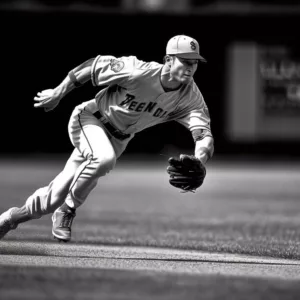 A catchers invitation to the next level is his evaluation of his pop time. Pop time like any other measurement in the game can be trained and improved. Where a catcher can go wrong is not just neglecting this level of training in his career but training ineffectively. There are tons of approaches out there that are very ineffective when it comes to training a catcher to develop an elite pop time.
A catchers invitation to the next level is his evaluation of his pop time. Pop time like any other measurement in the game can be trained and improved. Where a catcher can go wrong is not just neglecting this level of training in his career but training ineffectively. There are tons of approaches out there that are very ineffective when it comes to training a catcher to develop an elite pop time.
The biggest mistakes most approaches make when training to improve a catchers pop time is first working on the cocking of the throwing arm. This is important but does not come into training until after the leg work has been developed. The problem with starting with the throwing arm is that the catcher will not first develop the needed low half movements to drive the throwing arm, and the end result will always be limited.
In this article, I will give you the top ten most successful ways to improve a catchers pop time. I will also go over the issue of ball speed and pop time and last I will give you the best training program that includes these tips and a systematic approach to training them to significantly improve a catchers pop time.
Catchers Pop Time VS A Catchers Ball Speed
 The one interesting factor of a catchers pop time is that it doesn't always mean high ball speed. For example, a catcher can have an elite pop time of 1.8 seconds but have a low ball speed around 80mph. For example, look at Brandon Davis Perfect Game Player Profile. His catcher pop time is 1.82 and his ball speed is 79mph. Above average pop time and a below average ball speed. This is not uncommon and needs to be understood when training for an elite pop time.
The one interesting factor of a catchers pop time is that it doesn't always mean high ball speed. For example, a catcher can have an elite pop time of 1.8 seconds but have a low ball speed around 80mph. For example, look at Brandon Davis Perfect Game Player Profile. His catcher pop time is 1.82 and his ball speed is 79mph. Above average pop time and a below average ball speed. This is not uncommon and needs to be understood when training for an elite pop time.
The reason ball speed is not that big of a factor for pop time is because pop time is more based on time to target and not velocity to target. Simply put, if you take to much time to generate high ball speed then it doesn't matter how hard you throw the ball. The lesson here is that the catcher should find a balance between ball speed and time to release. All you can do to determine the best ball speed and release time is to test and measure it. Try adding more ball speed and then try being quicker to release. You should be able to find your sweet spot based on your current abilities.
The list of the top 10 tips below to improve catcher pop times will give you tips on improving your abilities which will change your sweet spot but make it easier for you to improve your pop time. This means you must always test and retest your sweet spot, so you know exactly where you are the most successful in your delivery, at the present time.
Top Ten Ways to Improve Catcher Pop Times
For the tools and program to implement these top ten tips to improving a catchers pop time refer to the 2X Velocity Program below.
 Improve Dorsiflexion to Improve Leg Speed/Power - This is one of the most important factors for a catchers performance. This is the mobility in the ankles. If you have poor mobility in the ankles then you will not be able to move explosively from your squat position. The reason is you will want to quickly pop your butt up to get your feet back under you when moving out of your squat which will reduce your leg power because of the loss of tension in the legs. This poor ankle mobility also forces you into a valgus ankle position which is the toes turning outward with the ankles and knees turning inward. This allows a catcher to get lower but the catcher loses leg power in return. A good way to test your dorsiflexion in your ankle is with a squat test. If you can squat your butt to the floor with your feet facing forward and your heels down then your ankle mobility is not an issue. If you can not squat deep without rolling onto your toes then you have an ankle mobility issue. Optimal mobility in the ankle joint must be trained in your training program if you want to develop and elite pop time. The 2X Velocity Program comes with a mobility routine.
Improve Dorsiflexion to Improve Leg Speed/Power - This is one of the most important factors for a catchers performance. This is the mobility in the ankles. If you have poor mobility in the ankles then you will not be able to move explosively from your squat position. The reason is you will want to quickly pop your butt up to get your feet back under you when moving out of your squat which will reduce your leg power because of the loss of tension in the legs. This poor ankle mobility also forces you into a valgus ankle position which is the toes turning outward with the ankles and knees turning inward. This allows a catcher to get lower but the catcher loses leg power in return. A good way to test your dorsiflexion in your ankle is with a squat test. If you can squat your butt to the floor with your feet facing forward and your heels down then your ankle mobility is not an issue. If you can not squat deep without rolling onto your toes then you have an ankle mobility issue. Optimal mobility in the ankle joint must be trained in your training program if you want to develop and elite pop time. The 2X Velocity Program comes with a mobility routine.- Improve Hip Mobility - Hip mobility is critical to all throwers and hitters. It is at a high demand for catchers because of the low squat positions to field the position. Poor hip mobility makes it harder to maintain balance in a low squat position which will fatigue the leg muscles. It also forces a high butt position which kills leg power and it reduces hip rotation which limits the load the catcher can put on the arm. A catcher should have optimal hip mobility to perform at an elite level. This can also be trained. In the 2X Velocity Program this is also apart of the weekly mobility routine.
- Enhance Power to Weight Ratio - Your ability to push power well over your own body weight will determine how fast you can move from a squat position in and out of your throw. This is critical for all positions on the baseball field but extremely critical for the catchers pop time due to the low squat position. This must be trained in an off-season strength and conditioning program like with the 2X Velocity Program.
- Learn Effective Feet Work - The feet work for moving quickly from the squat position to the throw is critical to reducing time and increasing power production. The feet work for an optimal pop time is a combination of a drive shuffle step from a linear to a lateral position. Once in the lateral position the shoulders are also closed and the drive leg is driving force into the front leg to optimize hip to shoulder separation. If the catcher does not have this movement pattern of the feet programed in his motor coordination then his timing will be off and his leg power will be limited. This will effect both time to release and ball speed which is detrimental to a catchers pop time. This must be trained using throwing drills specifically focused on this feet work. The 2X Velocity Program uses a drill based throwing program to train this feet work.
- Learn how to Open the Hips ASAP - Once the feet work have been perfected then the goal is to generate enough speed of movement and force production through the lower half to drive the hips completely open. The more open the catcher can push the hips before the arm moves into action the more load on the arm to increase ball speed. It is important to know that hip rotation is a product of the feet work and the force production of the legs. This can also be trained through throwing drills which is also included in the 2X Velocity Program.
- Learn Optimal Hip to Shoulder Separation - Once the catcher has mastered the feet work and the hip rotation timing then he must learn to convert this into optimal hip to shoulder separation. This means the more the back hip can separate from the back shoulder then the more load is placed on the arm. This is what will stretch and fire the arm at a faster rate. If a catcher feels too much hip to shoulder separation is increasing ball speed but slowing down his pop time then he can reduce separation to find his sweet spot. This is the main mechanical component where catchers need to adjust for better pop time. To learn more about this elite mechanical component checkout the 2X Velocity Program.
- Learn How to Stabilize Hips and Extend the Front Leg - The front leg and the glute muscle are the main components which stabilize the hips and core. Without a stable hip complex during trunk rotation and arm acceleration, ball speed and quickness to release is poor. The more stable the hips the better the foundation for the trunk and arm to accelerate off of. The key to this stabilization is the power of the front leg and glute. The mechanics of the front leg must be to extend the ankle and knee before the release of the throw. This will not only continue to stabilize the hips and core but it will push more force into the ball. The 2X Velocity Program trains this mechanically and builds the leg power needed in the strength and conditioning program.
- Learn a Faster Arm Path - The arm path of a 1.8 pop time for a catcher is short and fast. The key is to flex the arm to 90 degrees and then load the throwing arm scap into hip to shoulder separation. From there the arm will launch back into external rotation and then explode into elbow extension internal rotation and even pronation. You can learn more about this terminology and how to train these mechanics of the optimal arm path for the catcher in the 2X Velocity Program.
- Learn How to Get Into a Quick Cocked Position - Not only must the catcher learn the best arm path to increase pop time but he must learn the timing of the cocked position. The later the catcher is into the cocked position the harder he will throw but the more time he will loss to release. This is where a catcher must find the best timing of the cocked position with the opening of his hips to maximize ball speed without losing to much time to release. Wherever that sweet spot is for the catcher, it still is a quick cocking of the arm. So drills to train this quick cocking are critical to improving pop time. The 2X Velocity Program has a series of throwing drills to train this arm cocking.
- Learn How to Put All of these Mechanics Together in Less than 1 Second - All of these tips and mainly mechanics here will significantly improve a catchers pop time but only if the catcher can pull them all together in less than 1 second. This is what makes this really challenging is the speed of the movement that is required to perform at a top level. This is why a training program is critical. Just practicing these bits and pieces as you see fit is not going to turn you into an elite catcher. You need a program that has been proven successful to improve catcher pop times and one that gives you a calendar to follow and goals to work for. This is the 2X Velocity Program in a nutshell.
The #1 Catchers Pop Time Training Program
 The 2X Sub 2.0 Velocity Program is the only pure science based pop time enhancement program for catchers. It uses a 3 calendar system with two levels of off-season training to develop the elite catcher profile. The calendars include the proprietary drill based throwing program, Olympic based strength/power training program and the fast twitch based anaerobic conditioning program.
The 2X Sub 2.0 Velocity Program is the only pure science based pop time enhancement program for catchers. It uses a 3 calendar system with two levels of off-season training to develop the elite catcher profile. The calendars include the proprietary drill based throwing program, Olympic based strength/power training program and the fast twitch based anaerobic conditioning program.
Finally here is the pop time training program that actually gets the job done and is making a name for itself at all levels of the game.
If you would like to learn more, I would suggest you signup for the FREE 3 Part Series on 30 Days to a Top Prospect Player Profile or get started today taking your game to the next level with the 2X Velocity Program.



 Improve Dorsiflexion to Improve Leg Speed/Power - This is one of the most important factors for a catchers performance. This is the mobility in the ankles. If you have poor mobility in the ankles then you will not be able to move explosively from your squat position. The reason is you will want to quickly pop your butt up to get your feet back under you when moving out of your squat which will reduce your leg power because of the loss of tension in the legs. This poor ankle mobility also forces you into a valgus ankle position which is the toes turning outward with the ankles and knees turning inward. This allows a catcher to get lower but the catcher loses leg power in return. A good way to test your dorsiflexion in your ankle is with a squat test. If you can squat your butt to the floor with your feet facing forward and your heels down then your ankle mobility is not an issue. If you can not squat deep without rolling onto your toes then you have an ankle mobility issue. Optimal mobility in the ankle joint must be trained in your training program if you want to develop and elite pop time. The 2X Velocity Program comes with a mobility routine.
Improve Dorsiflexion to Improve Leg Speed/Power - This is one of the most important factors for a catchers performance. This is the mobility in the ankles. If you have poor mobility in the ankles then you will not be able to move explosively from your squat position. The reason is you will want to quickly pop your butt up to get your feet back under you when moving out of your squat which will reduce your leg power because of the loss of tension in the legs. This poor ankle mobility also forces you into a valgus ankle position which is the toes turning outward with the ankles and knees turning inward. This allows a catcher to get lower but the catcher loses leg power in return. A good way to test your dorsiflexion in your ankle is with a squat test. If you can squat your butt to the floor with your feet facing forward and your heels down then your ankle mobility is not an issue. If you can not squat deep without rolling onto your toes then you have an ankle mobility issue. Optimal mobility in the ankle joint must be trained in your training program if you want to develop and elite pop time. The 2X Velocity Program comes with a mobility routine.
I offer PopTime Clinics for catchers. This article is powerful support to what I teach particularly emphasizing legwork. I call it “building the throw/ catcher from the ground up”, with legwork as the foundation. “Armwork” is layered on top. In fact, it does not happen after the legwork… it happens during.
We’re are you located
Covington, LA
hi rick,
when and where do you offer your pop up times for catchers clinic? my son is turning 12 and currently a catcher and is interested in your clinic.
thanks
George, if you are interested I hold 2X Sub 2.0 Camps for catchers wanting to improve pop up times.
We’re and when do u give training my son is 7years old.Im out of inglewood ca
Louisiana is our Camps
Can you recommend any Texas training camps?
https://www.topvelocity.net/3x-coach/3x-pitching-instruction-texas/